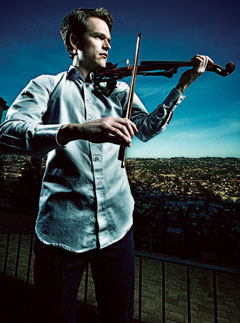


It's not exactly news that the violin is a great jazz instrument - violinist Joe Venuti proved it back in the 1920s, and players such as Stéphane Grappelli, Stuff Smith, Svend Asmussen, and Jean-Luc Ponty have all reinforced the point. Yet jazz violinists remain a relatively rare breed, and it can still be an act of rebellion for young players to choose Miles over Mendelssohn.
In fact, Mads Tolling might not be enjoying his current jazz success as the leader of his own quartet, a member of the GRAMMY-winning Turtle Island String Quartet, and a sideman for bass great Stanley Clarke were it not for the assistance of two players on the above list, Asmussen and Ponty.
"I always wanted to do something different," says the Copenhagen, Denmark, native. "I was never that excited about the idea of trying to be a section player in an orchestra. When I was 16 or 17, I was playing in regional and amateur symphony orchestras, and it just didn't get the spark going inside me."
Meanwhile Mads was developing a taste for jazz, thanks to his father's gift of a Miles Davis cassette. "Something in the sound really grabbed me, and I fell in love with it," he remembers. "But I hadn't yet realized that it might be possible to do something similar with the violin."

A breakthrough occurred when young Mads attended a concert by Asmussen, a fellow Dane whose long career includes credits with Duke Ellington, Fats Waller, Benny Goodman, and Lionel Hampton. "I called and asked him for lessons," recalls Mads. "He explained that he didn't teach, but told me to listen to Stuff Smith. That helped me understand that jazz is about self-study, a kind of study where you go to jam sessions, hang out with other musicians who can already play, and eventually pick up the tone."
Mads got deeper into jazz, a process he likens to learning a language. "It doesn't come easily," he admits. "You can just go to language class and not take it seriously, or you can really try to get the pronunciation right. And like learning a language, the best thing you can do is live in the country of the language you're studying."
Which is exactly what Mads did, accepting a scholarship to Boston's Berklee College of Music in 2000. There he met and jammed with visiting artist Jean-Luc Ponty, who recommended Mads to Stanley Clarke. Mads also joined the long-running Turtle Island String Quartet, first as violist and later as a violinist. With Tolling's help, the group won two GRAMMYS® in the Classical Crossover category.
Jazz/classical isn't the only crossover in Mads' career. His group, the Mads Tolling Quartet, often ventures into rock territory. Example: the bands's 2009 disc, The Playmaker, features a fiddle-fueled rendition of Led Zeppelin's "Black Dog." And as if that weren't "crossover" enough, the album has a professional sports theme, including Tolling compositions dedicated to such athletes as LeBron James, Tom Brady, and Zinedine Zidane.
The SV-250 really delivers, sound-wise. It's very light, easy to practice on, and it holds its tuning really well.
Mads is serious about the sports metaphors. "I'm a huge sports fan, and I play a lot of sports myself. A sports team is only as good as its weakest link, and the same is true in music. But as much as sports are about teamwork, it's also about you being present in the moment and doing well at any given time. It's a two-edged sword, if you will - it's about the team, but also about how you go about your business as an individual."
Tolling usually performs on a solidbody Yamaha SV-250 Silent Violin. "The SV-250 really delivers, sound-wise," he says. "It's very light, it's easy to practice on, and it holds its tuning really well. As much as I love the sound of an acoustic violin with a pickup, it just doesn't deliver quite enough at high volumes, especially when I play with Stanley Clarke, whose band lives at high decibel levels. It's not just a matter of the feedback problems you have with an acoustic instrument. It's also about the tone quality. The solidbody instrument gives the music more impact. The lines pop out and have a punch that people can feel, as opposed to something they just sort of hear in the background. Jean-Luc Ponty discovered this back in the '70s: You need more power and direct tone in order to cut through a rhythm section with drums."
(Photography Credit: Jay Blakesburg)
























